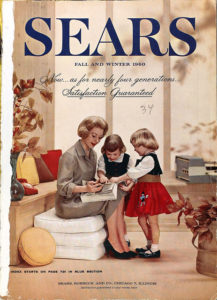
These mailmen today have it made. Why, back in my day, they used to haul a hundred pounds of catalogs five or six times a year!
One of the most pervasive memories we Boomers have locked away is a big catalog or two sitting on the coffee table right next to the ashtray. They would come in the mail annually from companies like Montgomery-Ward, Sears, J.C. Penney, and Spiegel. All it would take to receive them was to buy something at the store. If they got your name and address, the monstrous consumers of wood pulp would begin showing up automatically, generally laid on your welcome mat by those poor abused postmen of the 1960’s.
And there was something for everyone in those massive tomes. It seemed that women’s clothing took up the most real estate, for good reason. I’m sure it was female shoppers who comprised the bulk of the mail-order catalog business of the era. The customer is always right, load those books up with pretty pictures of dresses.
But kids got their share of cool stuff to look at too, particularly with the Christmas wish books. More on that in just a bit.
Back in the days before the internet, when discount stores carried stuff that was, well, discount (aka junk), consumers knew that they needed to deal with department stores for the good, high-quality stuff that would last years. Thus, the previously mentioned retail establishments would invest money in the big catalogs that would end up in our living rooms. It was good business.
The big catalogs provided a return on the investment of the retailers pretty much year-round, but as Christmas approached, things got really crazy. Crazy enough that the big boys would send you a second catalog in the fall, a bit smaller than the regular version, but this one aimed at the biggest customers of the period: KIDS!
Thus, we would grab that wish book, as they were known, and nearly wear it out looking at the monstrously wonderful toys to be found therein. After all, Sears didn’t mess with 99 cent toys in the wish book, they displayed absolutely gorgeous full-color images of race car sets, erector sets, model trains, Easy-Bake ovens, chemistry sets, and other expensive doors to paradise. It worked, too, our parents were relentlessly hounded right up until the big day.
It was a pleasant time for all but local retailers. They were losing sales to the catalog merchants. In fact, when the Montgomery-Ward catalog first began showing up in consumers’ mailboxes in the 19th century, it wasn’t unusual for local business owners to stage bonfires where piles of catalogs went up in smoke as a form of protest. More retailers joined up with their own catalogs, most notably Sears-Roebuck, who would become known as the most ubiquitous of the mail-order retailers, and local businesses had to learn to just deal with it.

Mail order catalogs had their heyday when we Boomers were kids, during the 50’s and 60’s. As stores began expanding into more and more areas, the shopping mall concept helping to spur this trend, the significance of the catalogs providing an easy way for customers to purchase things through the mail began to wane. The automatic mailings changed into a request-only service, you would receive a card in the mail and were required to mail it back in (free of charge) indicating that you wanted the latest offering. You also had the option of picking one up at the store down at the mall.
The big mail-order catalogs survived many economic ups and downs, but it was the internet that made them virtually disappear. The Sears catalog went away in 1993. Montgomery-Ward had problems maintaining their profitability, their catalog disappeared in 1985. You could recently request a J.C. Penney catalog through their website, but this has apparently been discontinued. However, don’t despair, at presstime you can still get a Spiegel catalog by requesting one at (link removed, no longer available)
Unfortunately, getting a Spiegel catalog in the mail won’t magically change the year to 1966, though.